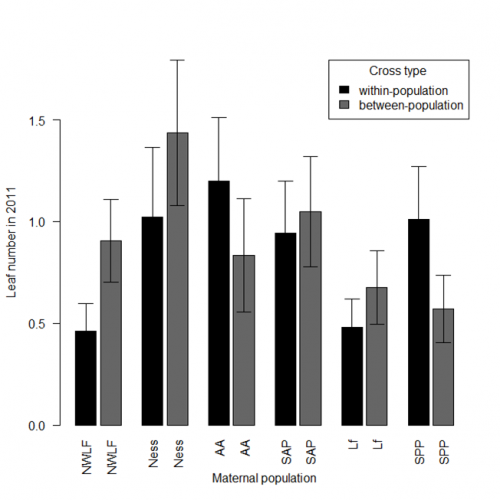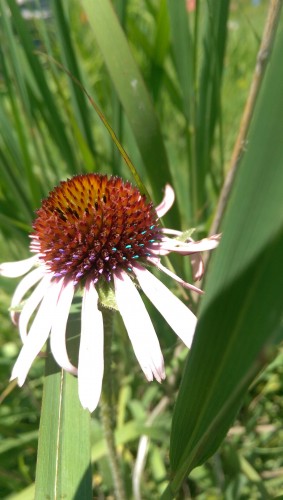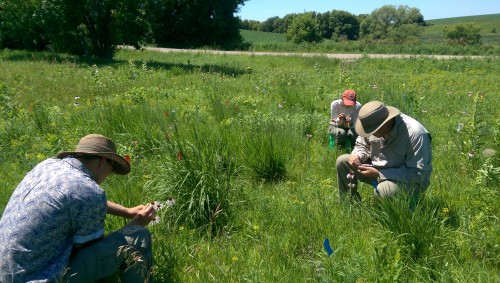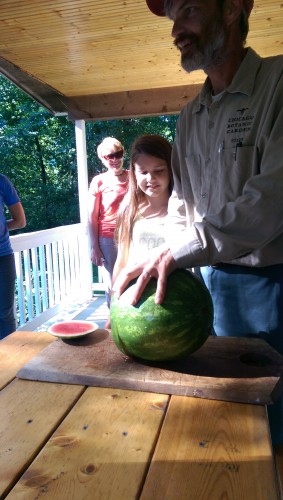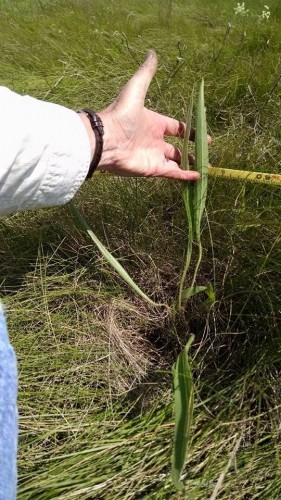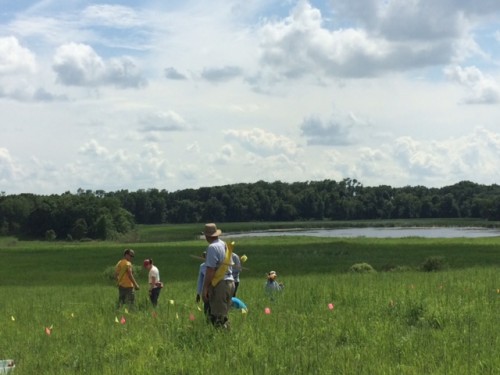|
|
At this point, I think we’ve all gotten into a good groove. Phenology on half of the sites went smoothly this morning. Ben and I worked at Landfill. I enjoyed watching the nearby herd of cows get chased out of a wetland by an angry man in an ATV while I methodically selected “Done Flowering” for a head with no more female or male florets. The sun was out but the grass was dewy. I worked on the East hill for the first time. By 11:20am, we headed back to the Hjelm house to work on phenology in p1. People trickled in from all the different routes, and by lunch all the phenology was complete. After a calm lunch, where I thought for the first time about brome-derived ethanol, the team split up to complete a few jobs. While Amy and Danny headed out to prepare for the next step in the Compatibility study, the rest of us worked in p1 or the Hjelm house itself on various tasks. I started painting bracts: Lavender along the western edge of each head’s center divide, Pink along the eastern edge, and white for pre-shriveled styles. It was the perfect afternoon for that kind of task. The sky was bright blue but punctuated with small white bursts of cloud. The air was warm and the sun turned my rubber boots into little foot ovens. But time felt purposeful and productive. When everyone had finished their jobs, we met back on the porch and debriefed the day. It was busy, fruitful, but most of all it felt comfortable and settled. We are hitting our stride as a team, working smoothly to divide tasks and communicating clearly. And I think I’ve found my new passion in field work.
 Pollinator Exclusion Bags On!  Bracts Painted!  Pollinator at work!  Dinner Time!!
Birds foot trefoil has slowly been making its way into P1 along with its buddy Canada thistle. The time has come to put an end to it! Today P1 was mapped out and all the invaders were marked for termination. The eradication will began right after the next rain. It looks like perhaps Friday will be the day as rain is looking good for Thursday. Everyone will have to glove up and teach these pesky invaders a lesson! Look further down the post to see how Will has devised a plan for extra triple protection from sun to take on the task!

Will has decided that extra protection will be needed to take on this task and its shown here demonstrating the latest in ultra triple protection. No sun will be getting in his eyes!

Today Brad and I finished the 2015 census on my crossing experiment plot.
The plants in this plot are the offspring of within-population or between-population crosses of Echinacea plants from six nearby prairie remnants. In most cases, the pollen for between-population crosses was supplied by the largest prairie remnant in the experiment, identified as SPP in the figure below. Crosses were made in the summer of 2008 (thanks to LOTS of help from Team Echinacea). We sowed a total of 15,491 achenes into this plot in the fall of 2008. We estimated that about 40% of the achenes contained embryos, based on their weights.
In the spring of 2009, we found 396 seedlings. We found an additional 43 seedlings in late summer, 2009, and another 10 new seedlings in the summer of 2010. In 2011, we were only able to find 264 of these plants, and the numbers have continued to decline: we found 185 in 2012, 124 in 2013, 112 in 2014, and 89 this summer (2015). We have yet to observe any flowering!
 As you can see from the graph (based on results through 2011), results of within- and between-population crosses have been mixed. The columns in the graph represent estimated mean total leaf number for each cross, for a starting number of 25 achenes, based on an analysis of total fitness (using an aster model). The main effect of cross type was non-significant; however, there was a significant effect of maternal population, and a statistically significant interaction between maternal population and cross type. In other words, the success of the type of cross depended on the maternal plants that were crossed. For the smallest population (identified as NWLF), offspring of between-population crosses outperformed within-population crosses. For the largest population (SPP), the within-population crosses performed better than the between-population crosses. As you can see from the graph (based on results through 2011), results of within- and between-population crosses have been mixed. The columns in the graph represent estimated mean total leaf number for each cross, for a starting number of 25 achenes, based on an analysis of total fitness (using an aster model). The main effect of cross type was non-significant; however, there was a significant effect of maternal population, and a statistically significant interaction between maternal population and cross type. In other words, the success of the type of cross depended on the maternal plants that were crossed. For the smallest population (identified as NWLF), offspring of between-population crosses outperformed within-population crosses. For the largest population (SPP), the within-population crosses performed better than the between-population crosses.
What implications can we draw from these results? In some cases a small, inbred remnant population may be enhanced by cross-breeding with another local population (this is called “genetic rescue”). However, between-population crosses also run the risk of outbreeding depression, as we have observed for the SPP-Lf cross, compared to the SPP-SPP within-population cross.
We now have 4 more years of data, with quite a bit of mortality. It will be exciting to perform another analysis including more data!
 Ben Lee (2015); ballpoint pen on notebook paper It was a good Saturday of phenology and fun for Team Echinacea! A group of us braved the morning fog and went out to our remnant sites to assess phenology. Lots of plants have reached or are nearing the end of their flowering time already. Later in the day we went swimming, played bananagrams, and drew blind contour drawings of each other.
This weekend, Danny and I have been working the ongoing project assessing compatibility between Echinacea individuals within remnants. On Friday, we went to Loeffler’s Corner and randomly selected 10 flowering plants; these are our focal plants. We do four crosses on each focal plant, with pollen from each of the crosses being placed on four or 5 bracts of the focal plants. We can tell if the cross is compatible by seeing if the styles shrivel after receiving pollen; if they do, they’re compatible, but if the styles persist, then the cross was between two plants that are not compatible.
For this study, we cross each focal plant with its nearest flowering neighbor, its furthest flowering neighbor, a plant that flowered early (i.e. one that is just ending flowering), and a plant that flowered late (i.e. one that just started flowering). To keep track of the crosses, we paint the bracts of the focal plant different colors which correspond to the cross that the style will receive: near, far, early, or late. We paint bracts corresponding to male florets; the next day, they will be styles, and we will be able to do the crosses. After we paint, we cover each focal flower with a pollinator exclusion bag so that we can be sure that no other pollen is introduced.
On the next day, Saturday, the styles of our focal plants emerged. We collected pollen from the various pollen donors and used a toothpick to perform the crosses, carefully placing pollen onto the styles identified by their painted bracts. We cover the focal flowers back up with the pollinator exclusion bags and wait one day to see if the styles shrivel.
This morning, Danny and I went back out to Loeffler’s to check on style shriveling. Here are the results!
| |
Compatible |
Incompatible |
Inconclusive |
| Nearest neighbor |
9 |
1 |
0 |
| Farthest neighbor |
7 |
2 |
1 |
| Early flowering |
7 |
1 |
2 |
| Late flowering |
9 |
1 |
0 |
Here I’m considering a cross compatible if 75% or more of the styles shriveled, incompatible if 25% or less shriveled, and inconclusive if it is anywhere in between. We’ll go back tomorrow to check on crosses that weren’t either 100% shriveled or not shriveled and see if any more styles have shriveled in that time.
Hopefully we’ll be able to repeat this process on several more remnant populations this coming week!
 My beautiful bracts!  Ben, Gina, & Matt practice precise painting Today was another successful day with the team! We had a morning filled with phenology at half of the sites and later everyone divided to get many things accomplished. After lunch, some of us practiced painting the bracts of Echinacea; this wasn’t too hard, it was actually very pleasant. Using toothpicks, we had to be sure to paint the tops of bracts as well as the bottom while making sure not to get paint on the florets or apply too much.
 I see absolutely nothing wrong here. Here, Lea and I were at p2 collecting phenology data in the afternoon. There are 80 rows in this plot and it took us almost the whole day to get the job done! I’m from the south and it honestly takes a lot for me to confess that a place is hot, but the way the sun was blazing today, I wasn’t sure if I’d make it out of the prairie to deliver this flog post to you! It was so “warm” today I was seeing double headed Echinacea…….. sheesh.
To conclude a week full of accomplishments, Stuart sliced up the best watermelon ever. One shouldn’t argue this watermelon’s caliber; I know this was the best watermelon ever because it replenished all the sense I lost in p2 today. I’d say that everyone else enjoyed this glorious melon as well! Today was a good Friday!
 Watermelon after work!
 Thanks to some critical help from Team Echinacea, we were able to complete the 2015 census on the local adaptation experiment this week. We found a total of 282 live Echinacea plants this summer (compared to 372 in 2014). 96 of the survivors live in the western South Dakota plot, and 186 in the Hegg Lake plot. None of the plants have yet flowered, though some of the western SoDak plants seem to be large enough (see photo). Maybe next year! Thanks to some critical help from Team Echinacea, we were able to complete the 2015 census on the local adaptation experiment this week. We found a total of 282 live Echinacea plants this summer (compared to 372 in 2014). 96 of the survivors live in the western South Dakota plot, and 186 in the Hegg Lake plot. None of the plants have yet flowered, though some of the western SoDak plants seem to be large enough (see photo). Maybe next year!
This morning Gretel took us all down to P1, and we learned the proper way to collect pollen from plants and put it onto other plants. After getting to practice that ourselves, we split into small groups and went to do various jobs. Everybody agrees that Gina and Will got the best job. They went out to Hegg Lake and got to cut off all the Echinacea pallida heads. Now we have a beautiful bouquet of them on our lunch table! Per and I got to bag flower heads in P1 that will potentially be used in the cross-pollination experiment.
 Amy is excited to bag heads at landfill! After lunch, a group of us got sent out to Hegg Lake to help Taylor flag the rest of her hybrid plot. We found lots of little Echinacea plants and measured all their leaves.
 Done flagging the hybrid plot!
Another long morning of phenology
Nobody knew the protocol, apparently
Gretel sunk our visors one by one
Until 12:30 we toiled in the sun
So much end of flowering to observe
The plants have been thriving at Staffanson Preserve
Into boots our feet slid after lunchtime fun
For Hegg Lake had much more work to be done
On the hills we tagged more angustifolia flowers
Lots of us also helped Taylor and Amy for hours
If only we understood those rogue Echinacea plants…
Another cruel joke by Team Pallida, perchance??
 Measuring baby hybrids for Taylor’s experiment!
As we are wont to do in team Echinacea 2015, we started the day with a wonderful bout of phenology. The number of newly discovered plants is really starting to slow down but as we get closer to peak flowering, more and more will become apparent. Speaking of peak flowering, it seems to be almost that time of year for the Echinacea, some sites, like Landfill, are already seeing plenty of heads near the end of their flowering for the summer. Both p1 and p2, having been burned this year, are a little slower on the uptake but they’re starting to gain momentum.
 A “done flowering” Echinacea leads the way for its flowering brethren. Before lunch, Stuart took a group of us out and showed us the proper technique for painting the bracts to identify styles for hand-crosses. We made some paint holsters and feel ready for some compatibility assessment!
We put the GPS units away,
And began a day of phenology in the purest,
The amount of flowers we saw was cray,
our maps made our observations the surest.
I jumped in a car and went not at all far,
To the virgin plains of Staffanson,
Where few tree do the landscape mar,
We toiled restlessly unti lthe work was done.
The sun rose high in the sky,
I prepared the plots for the plunder of seeds,
Through the prairie I did fly,
With dreams of harvesting seeds to stop weeds.
Peak flowering has almost begun,
With the flowers thriving in the heat of the sun.
 To bee or not to bee
|
|







